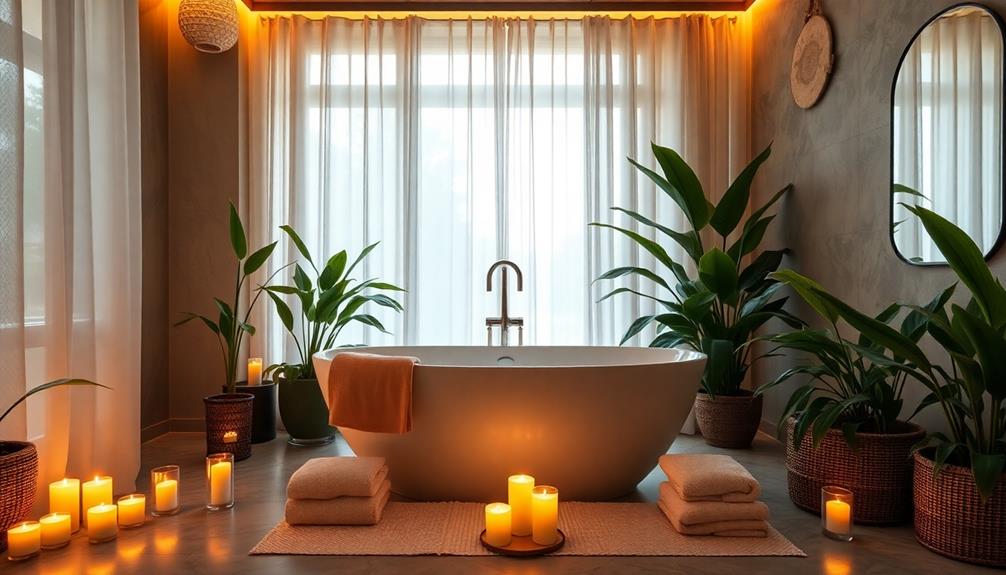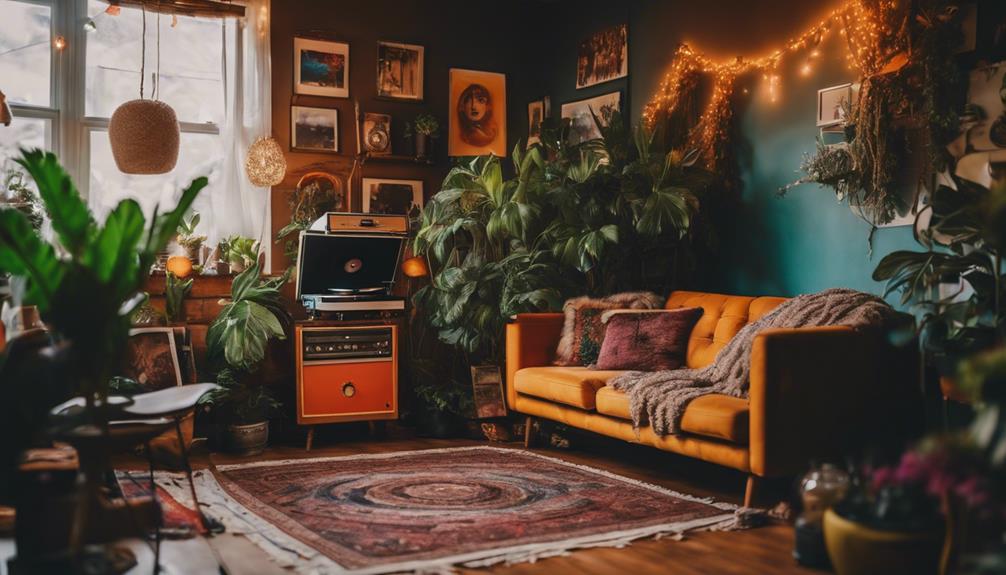You can easily transform your home into a soothing spa retreat that enhances your well-being and relaxation. Start by decluttering your space to promote calmness and mental clarity. Use soft, ambient lighting and calming music to create a serene atmosphere. Incorporate essential oils for soothing scents and consider hot towels for muscle relief. Add personal touches like plush towels and herbal teas to elevate your experience. Don't forget indoor plants or calming artwork to bring nature indoors. With these simple adjustments, you'll create your perfect sanctuary—stick around, and you'll discover even more ways to enhance your spa-like escape.
Key Takeaways
- Create a serene atmosphere with soft ambient lighting and soothing music to promote relaxation and calmness.
- Utilize essential oils or scented candles to fill your space with calming fragrances that enhance your well-being.
- Incorporate comfortable items like plush towels, pillows, and blankets to invite unwinding and comfort in your environment.
- Maintain tidiness and declutter to promote mental clarity and reduce stress in your home spa retreat.
- Brew detoxifying herbal teas, like chamomile, to enhance your relaxation experience and elevate your mood.
Benefits of a Spa Retreat

When you transform your home into a spa retreat, you're not just treating yourself to luxury; you're investing in your well-being. This experience offers numerous benefits, helping you unwind from daily stress.
Incorporating essential oils can enhance your relaxation; for instance, essential oils for respiratory health can contribute to a soothing atmosphere, promoting deeper breathing and calming your mind.
You'll find that creating a spa-like atmosphere promotes relaxation, rejuvenating your mind and body. Hot towels can enhance your self-care routine, soothing tired muscles and improving blood circulation. They also open up your pores, making them ideal for skincare treatments.
Incorporating aromatherapy can elevate your experience, uplifting your mood and enhancing tranquility.
Creating a Relaxing Atmosphere

One of the keys to transforming your home into a spa retreat lies in creating a relaxing atmosphere. To start, declutter your space; a tidy environment helps clear your mind.
You might also consider incorporating elements that promote overall health, such as a detoxifying beverage, which can enhance your relaxation experience.
Soft, ambient lighting can set the mood, so consider using candles or dimmable lamps. Incorporate soothing colors like soft blues and greens in your decor to promote tranquility.
You can also play calming music or nature sounds to enhance relaxation. Don't forget to introduce pleasant scents; essential oils or scented candles can uplift your mood.
Finally, surround yourself with comfortable items—soft pillows and blankets invite you to unwind.
With these adjustments, you'll create a serene space that invites relaxation and rejuvenation, making your home feel like a true spa retreat.
Essential Spa Elements

To achieve a true spa experience at home, focus on incorporating essential elements that promote relaxation and rejuvenation.
Start with soft, ambient lighting—think candles or dimmable lamps—to create a calming atmosphere. Next, add soothing sounds, like gentle music or nature sounds, to enhance tranquility. Incorporate natural scents using essential oils or incense; lavender and eucalyptus are fantastic choices.
For an added touch of comfort, consider sipping on herbal teas like chamomile, which may help alleviate stress and promote relaxation best herbal tea for period pain. Create a cozy space with plush towels and pillows, inviting you to unwind.
Don't forget about hydration; keep invigorating herbal teas or infused water on hand. Finally, consider including elements like indoor plants or soothing visuals, such as calming artwork, to elevate your spa retreat.
These simple additions will transform your home into a peaceful sanctuary.
Incorporating Hot Towels

Incorporating hot towels into your home spa experience can elevate your relaxation routine profoundly. These warm, soothing towels help relieve stress, promote blood circulation, and ease tired muscles.
To create the perfect hot towel, you can dampen a clean towel and heat it in the microwave for about 30 seconds to one minute. Drape the towel over your shoulders or wrap it around your face to open your pores during skincare routines.
For an added touch, infuse your towels with essential oils like lavender or chamomile to enhance your relaxation. Pairing hot towels with meditation or soft music creates a serene atmosphere, transforming your space into a true spa retreat.
Enjoy the calming effects and let your worries melt away.
Choosing Spa Treatments

After enjoying the soothing effects of hot towels, you're ready to enhance your home spa experience with thoughtfully chosen spa treatments.
Selecting the right treatments can elevate your relaxation and rejuvenation, especially when considering practices like yoga for back pain that can complement your spa routine.
Consider incorporating these options into your routine:
- Facial masks: Hydrate and nourish your skin for a revitalized glow.
- Body scrubs: Exfoliate to remove dead skin cells and improve circulation.
- Aromatherapy: Use essential oils to create a calming atmosphere and enhance mood.
- Foot soaks: Treat your feet to a warm soak with Epsom salts for ultimate relaxation.
Personalizing Your Experience

Personalizing your home spa experience can greatly enhance your relaxation and rejuvenation.
Start by selecting scents that resonate with you—lavender for tranquility or citrus for energy. Choose soft, plush towels that feel good against your skin and add your favorite essential oils to elevate the soothing effects.
Create a calming playlist that matches your mood, whether it's gentle piano music or nature sounds. You might also consider adjusting the lighting; soft lanterns or candles can create a warm, inviting atmosphere.
Finally, think about incorporating personalized treatments, like specific facial masks or scrubs that cater to your skin type.
Maintaining Spa Ambiance at Home

Creating a serene spa ambiance at home requires attention to details that engage your senses and promote relaxation.
Start by setting the right mood with soft lighting and soothing music. Incorporate elements that calm your mind and body, making your space feel inviting.
- Use essential oils or scented candles to fill the air with calming fragrances.
- Keep your space tidy and organized to reduce stress and distractions.
- Add plush towels and comfortable seating to enhance comfort.
- Incorporate natural elements like plants or stones to connect with nature.
Frequently Asked Questions
How Often Should I Refresh My Spa Ambiance?
You should refresh your spa ambiance regularly to keep it inviting. Change scents, adjust lighting, and swap decor every few weeks. This keeps the atmosphere rejuvenating and guarantees you always feel relaxed and inspired.
What Are the Best Essential Oils for Relaxation?
Imagine unwinding after a long day, breathing in lavender's calming scent. You'll find lavender oil's soothing properties perfect for relaxation; it eases stress and promotes tranquility, helping you feel more centered and at peace.
Can I Use Regular Towels Instead of Spa Towels?
You can definitely use regular towels instead of spa towels. Just make certain they're clean and soft. For a better experience, consider using cotton or bamboo towels for added comfort and absorbency during your self-care routine.
How Long Do Hot Towels Stay Warm?
Hot towels typically stay warm for about 10 to 15 minutes, depending on the heating method used. To maintain warmth, keep them wrapped or in a towel warmer until you're ready to use them.
Are There Specific Foods to Enjoy During a Spa Day?
During a spa day, enjoy light, revitalizing foods like fruit platters, yogurt, or cucumber sandwiches. These options nourish your body without weighing you down, enhancing relaxation and keeping you feeling revitalized throughout your experience.
Conclusion
You might think transforming your home into a spa retreat is too complicated or expensive, but it doesn’t have to be! With just a few simple tweaks, like dimming the lights, playing soft music, and using everyday items, you can create a soothing environment. Embrace this self-care journey, and you’ll find that even small changes can lead to a profound sense of relaxation. So go ahead, treat yourself—you deserve it! Make every day feel like a mini getaway. Additionally, consider incorporating some aromatherapy by diffusing essential oils or lighting scented candles. And don’t forget to pamper yourself with nourishing recipes for homemade face masks or bath soaks. These simple touches can elevate your spa retreat at home and help you truly unwind and recharge. So why wait? Start creating your own little oasis today!









